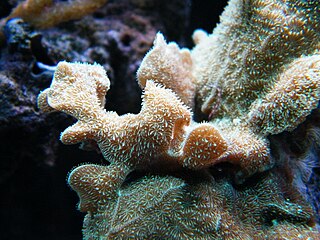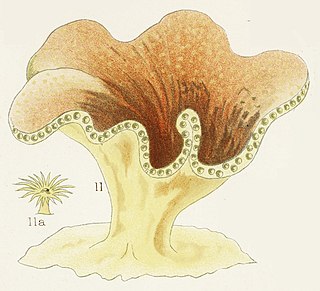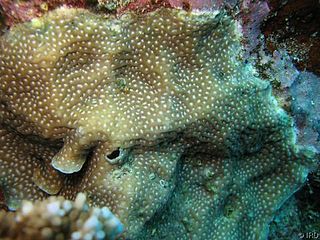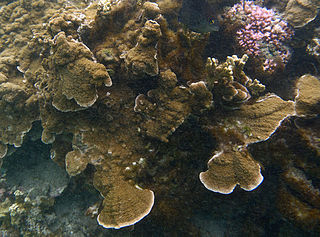
Stylophora pistillata, commonly known as hood coral or smooth cauliflower coral, is a species of stony coral in the family Pocilloporidae. It is native to the Indo-Pacific region and is commonly used in scientific investigations.

Pavona cactus, the cactus coral, potato chip coral or leaf coral, is a species of colonial stony coral in the family Agariciidae. This coral is found in shallow waters on reefs and in lagoons in tropical parts of the Indo-Pacific region.
Alveopora fenestrata is a species of stony coral that is found in the Red Sea, the Gulf of Aden, the southwest and northern Indian Ocean, the central Indo-Pacific, Australia, Southeast Asia and the oceanic west Pacific Ocean. It can be found in shallow coral reefs, to a depth of 30 metres (100 ft). It is particularly susceptible to coral bleaching.

Turbinaria is a genus of colonial stony corals in the family Dendrophylliidae. Common names for this genus include disc coral, scroll coral, cup coral, vase coral, pagoda coral and ruffled ridge coral. These corals are native to the Red Sea, Indian Ocean, Japan and the south Central Pacific Ocean.

Turbinaria stellulata, also known as disc coral, is a species of colonial stony coral in the family Dendrophylliidae. It is native to the Indo-Pacific region. The International Union for Conservation of Nature has rated its conservation status as being "vulnerable".

Turbinaria mesenterina, commonly known as disc coral, is a species of colonial stony coral in the family Dendrophylliidae. It is native to the Indo-Pacific region. The International Union for Conservation of Nature has rated its conservation status as being "vulnerable".

Turbinaria peltata, commonly known as disc coral, is a species of colonial stony coral in the family Dendrophylliidae. It is native to the Indo-Pacific region. The International Union for Conservation of Nature has rated its conservation status as being "vulnerable".

Turbinaria bifrons, commonly known as disc coral, is a species of colonial stony coral in the family Dendrophylliidae. It is native to the Indo-Pacific region. It is a zooxanthellate coral that houses symbiont dinoflagellates in its tissues. This is an uncommon species and the International Union for Conservation of Nature has rated its conservation status as being "vulnerable".

Turbinaria frondens, commonly known as disc coral, is a species of colonial stony coral in the family Dendrophylliidae. It is native to the Indo-Pacific region. It is a zooxanthellate coral that houses symbiont dinoflagellates in its tissues.
Turbinaria conspicua, commonly known as disc coral, is a species of colonial a stony coral in the family Dendrophylliidae. Found abundant in the eastern Indian Ocean and the western Pacific region, including Indonesia, Papua New Guinea and northern Australia. It is a zooxanthellaa coral that houses symbiont dinoflagellates in its tissues. It was studied by Bernard in 1896 and he rated it as a least concern species by the International Union for Conservation of Nature (IUCN).
Turbinaria radicalis, also known as disc coral, is a species of colonial stony coral in the family Dendrophylliidae. It is native to the central Indo-Pacific, tropical and sub-tropical Australia, the South China Sea, northern Australia and the West Pacific. It is a zooxanthellate coral that houses symbiont dinoflagellates in its tissues. It is a rare coral throughout its range and the International Union for Conservation of Nature has rated its conservation status as being "near-threatened".

Turbinaria patula, commonly known as disc coral, is a species of colonial stony coral in the family Dendrophylliidae. It is native to the Indo-Pacific region, being found in the eastern Indian Ocean, northern Australia, the South China Sea and the western Pacific Ocean. It is a zooxanthellate coral that houses symbiont dinoflagellates in its tissues. It is an uncommon species and the International Union for Conservation of Nature (IUCN) has rated it as a "vulnerable" species.

Seriatopora caliendrum is a species of colonial stony coral in the family Pocilloporidae. It forms a bushy clump and is commonly known as the green birdsnest coral. It is native to East Africa, the Red Sea and the western Indo-Pacific region, the type locality being the Red Sea. It grows in shallow water on reef slopes, particularly back-reef slopes, at depths down to about 25 metres (82 ft). The International Union for Conservation of Nature has assessed the conservation status of this species as being "near threatened".

Coelastrea aspera is a species of stony coral in the family Merulinidae. It is a colonial species native to the Indo-Pacific region where it occurs in shallow water. It was first described by the American zoologist Addison Emery Verrill in 1866 as Goniastrea aspera but it has since been determined that it should be in a different genus and its scientific name has been changed to Coelastrea aspera. This is a common species throughout much of its wide range and the International Union for Conservation of Nature has rated its conservation status as being of "least concern".

Favites complanata is a species of stony coral in the family Merulinidae, sometimes known as the larger star coral. It is native to the Indo-Pacific region and its range extends from the Red Sea and Indian Ocean to the western and central Pacific Ocean. This is an uncommon species of coral and seems to be decreasing in abundance, and the International Union for Conservation of Nature has rated its conservation status as being "near threatened".

Platygyra lamellina, the hard brain coral, is a species of colonial stony coral in the family Merulinidae. It occurs on reefs in shallow water in the Indo-Pacific region. The International Union for Conservation of Nature has assessed its conservation status as being "near threatened".

Oulophyllia crispa, sometimes called the intermediate valley coral, is a species of stony coral in the family Merulinidae. It is native to the tropical western and central Indo-Pacific region. Although this coral has a wide range, it is generally uncommon and seems to be decreasing in abundance, and the International Union for Conservation of Nature has rated its conservation status as being "near threatened".

Pavona bipartita, sometimes known as leaf coral, is a species of colonial stony coral in the family Agariciidae. It is found in shallow water, on reef slopes and on vertical surfaces, in tropical parts of the western and central Indo-Pacific region.

Pavona decussata, sometimes known as leaf coral, is a species of colonial stony coral in the family Agariciidae. It is found in shallow water in various reef habitats, particularly on gently sloping surfaces, in tropical parts of the western and central Indo-Pacific region.

Echinophyllia aspera, commonly known as the chalice coral, is a species of large polyp stony corals in the family Lobophylliidae. It is a colonial coral which is partly encrusting and partly forms laminate plates or tiers. It is native to the western and central Indo-Pacific.



















